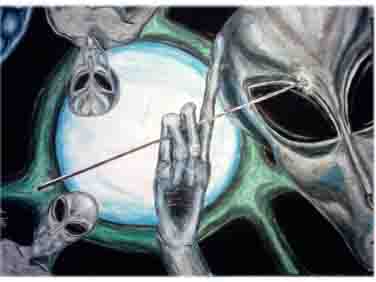Saturday, March 31, 2012
Friday, March 30, 2012
Flying Saucer Cult of the Day: The Aetherius Society
Who's "Really" inside the UFOs, indeed? Our benevolent interplanetary overlords, of course! The Aetherius Society is dedicated to working with our Cosmic Masters to use "mystical tools of white magic that can give you the spiritual power available only to advanced adepts centuries ago" in order to overcome the fact that "our world is accelerating into a world of selfishness and materialistic hedonism causing an increase in violence and terrorism around the world and a rapid depletion of Earth’s resources."
The Aetherius Society was founded by George King...
...a pretty serious-looking guy born in 1919 in Wellington, Shropshire, England. He puttered around at various labor professions including as a professional driver (of taxi cabs, limousines, and Jaguars which he test-drove), and also as a firefighter and a security guard. Then he got into Yoga, and from there just blundered into Eastern enlightenment teachings and from there - aliens!
From their FAQ:
Who Are The Cosmic Masters?
"The Cosmic Masters have visited Earth from time to time throughout history. It is the Cosmic Masters who have sent their emissaries to this planet throughout the ages. Beings such as Jesus, Buddha, Krishna, Lao Tzu, Patanjali and others are part of this Cosmic and Solar Hierarchy and have been responsible for giving to humanity our knowledge of Spirituality."
Why Do Flying Saucers Blink In and Out at Times?
"Normally we cannot see their spacecraft as they are for the most part operating on higher frequencies of existence. The Cosmic Masters are able to lower the vibrations of themselves and their spacecraft down to the physical level at will. This is why flying saucers are often seen to blink in and out."
See, everything has a logical explanation.
What Are the Main Beliefs of The Aetherius Society?
"Jesus, Buddha, Krishna and other religious leaders were of extraterrestrial origin and came to Earth to help mankind. Unlike many UFO groups we believe that extraterrestrials are friendly and are here to help humanity in our development. The Mother Earth is a living breathing entity which is thousands of lives more evolved than we are."
...hey, wait a minute, I've never heard of a UFO group that didn't believe in benevolent aliens. Who are these "many UFO groups"?
Anyway, rock on, flying saucer people!
Labels:
culture,
flying saucers,
magic,
mythology,
New Age,
oddities,
paranormal,
religion,
sci-fi,
weird
Thursday, March 29, 2012
Wednesday, March 28, 2012
The Two-Deck Turnover Trick - Try It!
Take two decks of ordinary playing cards. Keep the packs separate. Shuffle each of them. Now place both decks face down side-by-side and begin simultaneously drawing one card off each deck and revealing them.
Odds are better than 50/50 that at some point before you reach the bottom of the decks, you will eventually draw the exact same card of suit and rank from either deck at the same time.
I originally saw this in a recreational math book years ago, but I'll give the credit to this fascinating poker odds wizard, since seeing the trick on that page reminded me of it.
Labels:
cards,
magic,
math,
probability
Tuesday, March 27, 2012
Hypergraphia and the compulsion to create
A little while ago, the Wall-Street Journal published an article debunking the notion that creative people have a fundamental difference in how their brains work. This is along the way to encouraging people to bring out their inner creative genius.
Now, I'm all for encouraging everybody to think more creatively, simply because it's good healthy exercise for the brain. But if there's no structural difference in the brains of creative people, then how do you explain diseases like hypergraphia?
Hypergraphia is the overwhelming compulsion to write - external from any sense of reward. Among the famous cases of hypergraphics are Lewis Carroll, Vincent van Gogh, and Fyodor Dostoevsky. Here is an article on Dostoevsky's particular malaise. It is associated with conditions such as epilepsy and manic depression.
Not coincidentally, many famous authors have referred to their writing ability in terms of a disease:
"I go on working for the same reason that a hen goes on laying eggs." -- H.L. Mencken
"I am a galley slave to pen and ink." -- Honore Balzac
"Writing a book is a horrible, exhausting struggle, like a long bout of some painful illness. One would never undertake such a thing if one were not driven on by some demon whom one can neither resist nor understand." -- George Orwell
Then there is the case of people who had overwhelming compulsions to create - but only after they'd suffered some kind of brain trauma! It is these that make for some of the most fascinating cases...
It's a well-studied enough phenomenon that there's an article on the emergence of artistic talent in frontotemporal dementia. The Wisconsin Medical Society examines cases of acquired savant characteristics and "accidental" geniuses. Famous cases include the man who became a Michelangelo after a stroke and brain surgery.
While banging your head against the wall isn't recommended to make yourself an artistic genius, these cases do provide some argument that people with creative skills do have something different about their brains. Speaking on my own experience, blogging, drawing, coding, and other creative acts satisfy an urge in me that nothing else can reach. And yes, I tend to get ideas in clusters, too, which come absolutely unbidden whether I want them or not.
Labels:
culture,
language,
psychology,
science,
weird
Monday, March 26, 2012
The Visual Puzzle in Hans Holbein the Younger's "The Ambassadors"
You've probably seen this painting making the rounds on optical illusion websites:
It's become popular lately thanks to Google Art Project, the first attempt at putting high quality scans of paintings online for access. The curiosity value, of course, comes from the distorted view of the object in the extreme lower foreground, which resolves to a skull when viewed at the right angle:
In itself, the anamorphic perspective of the familiar momento mori technique is a splashy, attention-calling element. But why spoil an otherwise excellent Renaissance work, filled with masterful technique, with such a tacky carnival trick? Art scholars argue this motivation even today.
The rest of the painting is a double portrait, showing a kind of duality between the church and science. There is a cleric to the right and a merchant to the left. The objects scattered about the table between them continues this theme. In fact, like a David Lynch movie, the painting has various symbolic elements which are open to conflicting interpretations. But of course, like a car honking its horn, that stretched-out skull keeps distracting us.
Could it be that he was thumbing his nose at whomever commissioned the work? Was he adding the skull as a way of saying "this whole painting is a joke; don't take it seriously!" Was it to impress a certain person? Did he add this to cover up some mistake in the background? Is it perhaps a pointer to other thematic clues elsewhere in the painting? Is there some significance to where the painting would have originally have been hung - such as on the right-hand wall of a staircase near the bottom?
History may never know the motives of 16th-century Northern Renaissance painter Holbein.
Labels:
art,
history,
illusion,
mystery,
Renaissance
Friday, March 23, 2012
Nuclear Reactions Happen Naturally Too
Shown: The discovery of a 2-billion-year-old naturally-occurring nuclear reactor in Oklo, Gabon, Africa. What happened was that a uranium deposit in Precambrian times was triggered by groundwater seeping through sandstone. A chain reaction would initiate, boiling the water away, which would then cool the reaction but allow more water to seep in and repeat the cycle. The process apparently kept going for hundreds of thousands of years,
Oklo is the site of the only known natural nuclear reaction. French physicist Francis Perrin discovered the natural phenomenon in 1972. The French mined out the uranium in the area until supplies were depleted, but geologists and physicists have continued to study the area for clues about what happened there millenniums ago.
A great little educational video on how nuclear energy generators work:
Sunday, March 18, 2012
Bad Assumptions We Always Make About Extraterrestrial First Contact
Whenever I see a guide to what to do in case of first alien visitor contact (like this one), I always see the same stupid assumption made: the alien flew here in a big shiny ship, so obviously it's a highly advanced species compared to our own.
Bunk!
Then there's a section instructing you on how to scurry around trying to communicate with the aliens to show off how smart you are. You know, to prove we're sentient, and hence "worth getting to know".
Right there, there's some bad assumptions:
- Who says they wouldn't eat a smart species? Maybe they consider sentient species a rare delicacy.
- Maybe they actually aren't seeking out other sentient species. We humans, social animals, assume that the prime motivation for intergalactic travel is to party with some friends. Maybe the aliens want to think of themselves as the only sentient species in the universe, and they're just here to strip-mine the planet and leave.
- Maybe they're looking for slaves. If they're just out to snap a remote control onto your spine and make you do their bidding, extra IQ points just make you that much more useful.
- Maybe they met something else, like bats or dolphins, before they met you. And since it might turn out that bats or dolphins are smarter in their own way than humans are and if the aliens just happen to jive more with the other critters than they do with us, maybe all your showing off is for nothing.
- Maybe they rate intelligence on a different scale from us. Perhaps, like bees and termites, the aliens are born with instinct already in place so they intuitively grok math and engineering, but they judge intelligence based on how well you can juggle or how well you can sing in the 20-40 kHz range.
- Who's to say we don't scare the daylights out of them? There might be something about us that's horribly disturbing to them, like how we smell or the fact that we have hair. They'd be unable to see us as anything but hideous monsters and no matter how much smarts we show off, they'd just be consumed with the thought that anything as repulsive as us must die.
- You know how we humans have religions that make us expect crazy things to happen and react in bizarre ways? Now imagine aliens with some unfathomable dogma which dictates that Earth is Hell and everybody living on it is a demon. How do you P.R. your way out of that one?
We have to be lucky enough to have avoided all of those scenarios before we even have a chance of making a good first impression and having it do us any good. Now back to our first bad assumption: That the aliens, themselves, are advanced, or even sentient!
The first argument I usually find is "But they got here, so they obviously must be smart!"
Well, even an animal can float on water on a raft. Primitive tribe people rowed out to islands on boats. Maybe they got here by accident.
That's usually followed by "But they crossed interstellar space, so they must have invented faster-than-light travel!"
Please, if this was your first thought, sit down before you hurt yourself! Maybe the aliens have lifespans in the hundreds of millions of years, and so a trip of 17,000 years is just a relaxing nap to them. We humans have pathetically short lifespans, you know, even compared to many other species right here on Earth. It could turn out that we got stuck with the shortest lifespans of any sentient species in the universe, and so we are unable to conceptualize traveling to other stars without breaking the laws of physics in order to reach our destination before we die. Every other species can just launch a soapbox with a pile of TNT, pointed in the right direction, then patiently sit there waiting 17,000 years to reach their destination.
Or they could have a generation ship. Or they could just clone new bodies and use them for personal organ banks. Or maybe they've embraced technology to the point where they're cyborgs who effectively can just turn themselves off to save energy and have their extremely reliable electronics turn them on when they get here. Or maybe the big, shiny flying saucer is actually a scout ship built and launched from their space station out past Pluto.
See how humans have a hard time thinking outside of their tiny little frame of reference?
But beyond all of this, who says that we're talking to the smart alien race at all?
The first argument I usually find is "But they got here, so they obviously must be smart!"
Well, even an animal can float on water on a raft. Primitive tribe people rowed out to islands on boats. Maybe they got here by accident.
That's usually followed by "But they crossed interstellar space, so they must have invented faster-than-light travel!"
Please, if this was your first thought, sit down before you hurt yourself! Maybe the aliens have lifespans in the hundreds of millions of years, and so a trip of 17,000 years is just a relaxing nap to them. We humans have pathetically short lifespans, you know, even compared to many other species right here on Earth. It could turn out that we got stuck with the shortest lifespans of any sentient species in the universe, and so we are unable to conceptualize traveling to other stars without breaking the laws of physics in order to reach our destination before we die. Every other species can just launch a soapbox with a pile of TNT, pointed in the right direction, then patiently sit there waiting 17,000 years to reach their destination.
Or they could have a generation ship. Or they could just clone new bodies and use them for personal organ banks. Or maybe they've embraced technology to the point where they're cyborgs who effectively can just turn themselves off to save energy and have their extremely reliable electronics turn them on when they get here. Or maybe the big, shiny flying saucer is actually a scout ship built and launched from their space station out past Pluto.
See how humans have a hard time thinking outside of their tiny little frame of reference?
But beyond all of this, who says that we're talking to the smart alien race at all?
- Maybe we're actually talking to a robot. If you went across space with the responsibility of contacting aliens who, for all you know, might be hostile, would you rather send a robot avatar to test the water first, or just boldly charge out the hatch and risk becoming the first human victim of the disintegration ray?
- Maybe we're talking to an enslaved race, or the domestic pets of the race which built the spaceships. Same reasoning as the robots, and who says we're the first species the aliens have ever contacted? Maybe they've been setting up franchises all over the galaxy since before the tiny speck of dust we call home even formed?
- Since when do the engineers who designed the ship also become the ones assigned to drive it around? If an alien encounters your average human driving a car, should they assume that said human understands the intricacies of an internal combustion engine? You drive, but you have to take your car to a mechanic to be repaired (excepting those of you who are mechanics themselves), do you not?
- Think military: What invading army puts its head general at the front line? Maybe we're talking to the dumb grunts sent to scout us out for invasion and report back.
- We might be dealing with a hivemind. Like bees and ants, no individual member of a hivemind will have any noticeable intelligence; it's only together with its 100,000 sisters that it starts looking sentient.
- One more thing: Who says that anything built their ship at all? Maybe the ship itself is a life form, like a giant space turtle, or an asteroid covered in coral that steers it around. Maybe what we think of as the ship is actually the intelligent life form, and the beings we see riding on it are just parasites. We could go on all day here. It is impossible to think of every possibility - even our scientific exploration on Earth has rebuked us again and again with the stunning diversity of life and the unexpected ways it gets by!
I don't know what the rest of you have planned. Given all the unknowns, it may not matter at all what we do when that momentous first contact happens. The safest bet that I'm considering, should I be in the position of human race ambassador, is to turn the tables on them: make them prove their sentience to me first. I'll just start inspecting everything about them, and record and document everything I can. If they really are interested in meeting other smart species, they'll recognize this as a sign of my own sentience - maybe it will even be better to put them off-guard and feel a little intimidated, just in case they have hostile intentions.
But there is simply too much we humans assume about everything all the time to ever have the slightest idea what we should do when that moment comes.
Humans actually suck at trying to conceptualize in non-human ways. We have a hard enough time empathizing with our own next-door neighbor now.
Update: Over a year later, Why We'll Never Meet Aliens makes it to the front page of Slashdot. Note the backlash: I always see hate and ridicule from commenters when it's not starry-eyed utopia news. Apparently the Internet only reveres science if science is a big jolly guy handing out presents.
But there is simply too much we humans assume about everything all the time to ever have the slightest idea what we should do when that moment comes.
Humans actually suck at trying to conceptualize in non-human ways. We have a hard enough time empathizing with our own next-door neighbor now.
Update: Over a year later, Why We'll Never Meet Aliens makes it to the front page of Slashdot. Note the backlash: I always see hate and ridicule from commenters when it's not starry-eyed utopia news. Apparently the Internet only reveres science if science is a big jolly guy handing out presents.
Labels:
culture,
experimental,
fantasy,
flying saucers,
list,
nature,
paranormal,
physics,
sci-fi,
science,
technology,
weird,
zoology
A Quick, Helpful Guide to Determining Whether You Were Abducted By Aliens
From the Alien Abduction Insurance website:
"Clear facts indicating that you have been abducted by aliens:
You can hear voices in your head. This can probably be the sign indicating that you were abducted by aliens, but before claiming that fact make sure you don't have earphones on."
Interestingly, in the Wikipedia section on notable alien abduction claims, six of the eleven listed are from the USA. This means that either Americans are more interesting to aliens than anybody else, Americans are more prone to make a claim, or other countries are underreporting.
And don't forget to mark it on your calendars: March 20th is Alien Abduction Day. Along with making sure your bags are packed and your shots are current, that link will point you to many more helpful resources including hot spots for UFO watching and alien abduction safety (like, in case you want to refuse going, for some crazy unfathomable reason). The PDF pamphlet on "How To Refuse Alien Abduction" is solid gold, not to be missed.
Labels:
flying saucers,
New Age,
oddities,
paranormal,
sci-fi,
weird
Thursday, March 15, 2012
Backwards Sun
Question: If the sun rises in the Pacific Ocean and sets in the Atlantic Ocean, where are you?
Highlight for Answer:
In Central Panama. source
Saturday, March 10, 2012
A Different America With Different Entertainment: Disney's Adventure Through Inner Space
Speaking as a former Southern California mall rat, one of my favorite experiences from childhood was riding the "Adventure Through Inner Space" ride at Disneyland. They shut it down in the mid-80s to replace it with Star Tours - albeit, also a great attraction. But not the same. And it marked the point of cultural sea change in the United States between its peak and its decline. Here is the Yesterland page mourning its passing.
ATIS was a science fiction ride. In it, we use the excitement of cutting-edge (for the time) science to instill a sense of wonder, through the fantasy element of entering a magic microscope which makes you smaller. The cheery 1950s' song "Miracles From Molecules" greets you as you exit the ride - literally, the message is that the road to future Utopia was paved with scientific progress.
Star Tours is just about the Star Wars franchise and - there will be no way to avoid angering fans so I'll just say it - Star Wars is NOT science fiction. Star Wars is space opera, a Western cowboys-and-indians shoot-em-up set in space. Gone is the enthusiasm for science and the inspiration to look to a better tomorrow; instead the story, set "a long long time ago" is a Gothic post-modern fairy tale. What a poignant indicator to mark the shift in US culture! We gave up on getting into space ourselves - here, here's a fairy tale about how space politics would be just as messed up as US politics anyway. Enjoy your sour grapes.
ATIS sounds incredibly lame to modern kids, sounding more like a hyperthyroid science fair project than a ride, and that just goes to show how our modern culture has broken the present and new generations. To a six-year-old, years before the era of CGI effects, ATIS was scary. As you waited in line, they make it look like shrunken passengers were proceeding to the end of the microscope phasing into nothing. It was a stunningly realistic effect. The cars look like they go right up there. Near the end, a huge human eye peers down on you. The ride is mostly in darkness, with bright flashing lights all around you simulating thrilling interactions on the atomic level.
But all of this would be pretty pedestrian without the hypnotic voice of Paul Frees. As the narrating scientist, he commands your attention and shapes your thoughts with lines like "I am the first person to make this fabulous journey!" and "What compelling force draws me into this mysterious darkness--can this be the threshold of inner space?" and "No, I dare not go on. I must return to the realm of the molecule, before I go on shrinking...forever!" Frees could sit down to the breakfast table and describe his bowl of cereal and make it sound too epic for mere mortal minds to face.
Sadly, no actual video footage of this iconic and original ride exists, since it was shut down before the age of cheap video recorder cameras. But one fan, name of Steve Wesson, has devoted eight years to recreating it in 3D computer-modeling animation, and it is very close to my memories of the ride:
The architecture around the ride itself was a feast of googie nostalgia. Read that carefully, that's "googie" not "Google". "Googie" is the style of retro-futurist pop-art style, common around the general Disneyland area of Southern California. Check the definitive page on the Googie style here.
Can there be any more compelling argument that the United States gave up its dreams than that rides like ATIS and styles like googie now seem quaintly outdated? We used to look forward to the future - it was filled with exciting things and it made all the kids want to be scientists so we could get there as soon as possible and have out flying cars and robot maids. But our attitude towards the future changed from optimism to pessimism right about in the mid-80s. Cyberpunk came along, and with it came the cynical attitude that now said, "It wouldn't matter how much technology we invent; humans would be the same degenerate garbage anyway."
Right here in Iowa, we had yet another march in protest of a proposed bill that would allow exploration of building nuclear power facilities. Protesters dressed as zombies and marched on the state capitol.
I cried when I saw that story. Those zombies are no joke to me. The zombies want us to be governed by books that are thousands of years old. The zombies hate science and learning and love backwardness and repression. The zombies can't deal with sex or education or a president of a different race. The zombies will be here soon to snatch this computer out of my hands and take away my car, forcing us all back to the iron age to trod barefoot through the mud building pyramids while zombies crack a whip over our backs. The zombies are in power. The zombies own America, and the few remaining humans are scrambling to throw off their oppression or escape to a free land.
The United States has become a nation of zombies, dead things shambling forth to steal away the space-age, atomic-powered future promised to me in my childhood by Paul Frees and his Adventure Through Inner Space.
Labels:
50s,
architecture,
art,
culture,
Disneyland,
fantasy,
government,
mystery,
New Age,
physics,
politics,
sci-fi,
science,
technology
Tuesday, March 6, 2012
Bistro - Unforgettable short film
This under-three-minutes excursion into sparkly-eyed madness got awards at a 2011 film festival. Twilight Zone episodes (the new ones) don't have this much bite.
Labels:
2010s,
animal,
avant-garde,
cannibalism,
crazy awesome,
culture,
experimental,
video,
weird
Monday, March 5, 2012
Apocalypse Miau
The Internet keeps taking cat-worship to new heights... Along with extra-extra-cheesy '80s retro kitsch. Where will it all end?
Labels:
80s,
animal,
animation,
experimental,
fantasy,
film,
video,
YouTube-poop
Saturday, March 3, 2012
Fall In Love With Marika Rokk's Interpretation Of Space Cabaret
Marika Rokk was a dancer and singer of German film. Unfortunately, she was at the height of her popularity right during the Nazi era, so she became indelibly linked with it. Nevertheless, as seen by the campy, original style of this production, she's worth a second look.
This film from 1958, titled "Mir Ist So Langweilig" (It means "I am so bored") shows a moon-woman spying an African tribe on Earth and blasting down to be frolic with them for the sheer novelty of it. Despite the racist overtone (she even draws her finger across the chest of one dark man to see if it would rub off, but is promptly laughed at for this), it's full of charming touches like the swaying astronauts and a cute rocket with a gyroscopic cockpit.
This was done after her pardon from her post-WWII professional ban. For a while there, they didn't let her perform because she was so associated with the Nazis, which, let's face it, is hardly her fault since she couldn't help who buys a ticket to her shows.
Friday, March 2, 2012
The Film Pi Contains Math Errors
In Darren Aronofsky's 1998 film Pi, there's a scene where Max tells the Kabbalah that he's sure that they've completed their search for a number that is 216 digits long. He tells them,
"It's just a number. I'm sure you've written down every two hundred sixteen digit number. You've translated all of them. You've intoned them all. Haven't you? But what's it gotten you? The number is nothing!"
The problem is, this is impossible. There's 9.9*(10^215) 216-digit numbers. For comparison, recorded human history IN SECONDS is only 60x60x24x6000, about 1.8*(10^11). One billion computers, spitting out one number every second night and day since the dawn of human history, would not have generated every possible 216-digit number by now.
Numerous other math goofs at the IMDB page.
Subscribe to:
Posts (Atom)












